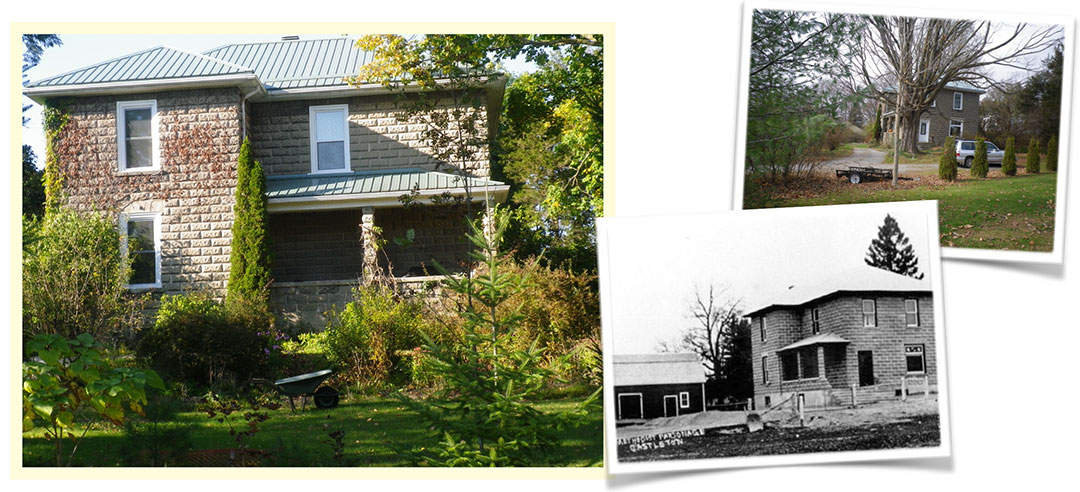182 Gould Street, Castleton
(c.1900 – 1920)
Roll No. 1411-011-050-04600 – Cramahe Township Ontario

Textile Block Design
No. 182 Gould Street in Castleton, is unique for the building material used and the architectural style that it evokes.
The textile-block houses were named for their richly textured brocade-like concrete walls. The style was an experiment by Frank Lloyd Wright in modular housing. He sought to develop an inexpensive and simple method of construction that would enable ordinary people to build their own homes with stacked blocks. By adding ornamental designs to mass-produced concrete blocks, Wright hoped that they could become a “masonry fabric capable of great variety and architectural beauty.” One writer has described Wright’s concept this way: “By unifying decoration and function, exterior and interior, earth and sky — perforated blocks served as skylights — Wright saw his Textile Block Method approach as an utterly modern, and democratic expression of his organic architecture ideal.”
In researching this building material and style, it is evident that 182 Gould Street is a modest and restrained version of the Textile Block Method and style. The five most famous Wright residences constructed using the Textile Block Method are quite elaborate and have multiple decorative elements. (John Storer; Samuel Freemen; Charles Ennis; Aline Barnsdall and George Sturges houses).
The only other evidence of the use of Textile Blocks in the area can be found at No. 157 Norway Street in Castleton, once an elementary school and now a private residence. The foundation is Textile Block with Northumberland red brick walls).
History or Associative Value
Written on front of the vintage picture of 182 Gould Street above is the phrase “Methodist Parsonage, Castleton”. Many of the Methodist churches which were among the first formal religious institutions in Upper Canada in the 19th century, became United churches on June 10, 1925 in Toronto, Ontario. The church continued to own the property until 1955.
Additional Historical and Genealogical Information
182 Gould Street, Castleton, Ontario
Cramahe Township, Concession 7, Lot 34, Castleton Lot 81
When Cramahe Township was first surveyed in the 1790’s a seventh of its land was set aside for crown reserves and another seventh was set aside for clergy reserves. These reserves were rented to tenant farmers. The revenues from the crown reserves went to the government. The revenues from the clergy reserves originally went only to the Church of England (Anglican), but after 1824 the Church of Scotland (Presbyterian) was granted a share, and by the 1840s all of the major protestant denominations were included (except the Baptists, who refused to participate). The clergy reserve system came to an end in 1854, when all revenues reverted to the government.
The first official owner of the land on which the house at 182 Gould Street now stands was the Canada Company. The Canada Company was a private British corporation incorporated in 1826 to aid in the development and colonization of Upper Canada with an emphasis on the Crown and Clergy Reserves. Among the lands acquired by the Canada Company were the southern 100 acres of Concession 7, Lot 34, Cramahe Township, where the western part of Castleton now sits. The Company was granted this land by the Crown on 28 May 1830.
By 1834 the 100 acres were in the hands of Joseph Abbott Keeler (1788-1855). No record has been seen of his acquiring them from the Canada Company, although there is an 1881 document certifying that the transfer had indeed been made. The Keelers were involved in the history of the area long before they were official owners of this property, having built a mill in Castleton as early as 1806.
Joseph A. Keeler sold of bits and pieces of this property over the years and what was left went to his son Joseph Keeler (1824-1881) on 23 September 1854. Almost exactly three years later (21 September 1857), the younger Keeler sold Castleton Lot 81 to Hugh Mills Bunbury (1833-1902), listed simply as “gentleman” on the purchase document for this property, but as a miller in the 1861 census. He was already a resident of Castleton when he purchased the Lot. Bunbury’s wife was Adelaide Cole (1842-1910) and reference has been found to two children: Anna (ca. 1858-?) and Hugh (ca. 1860-?).
By the time Bunbury had sold Lot 81 to the Wesleyan Methodist Church on 23 October 1868, he had moved to Woodstock, between Brantford and London.
The Church continued to own the property until 1955.
